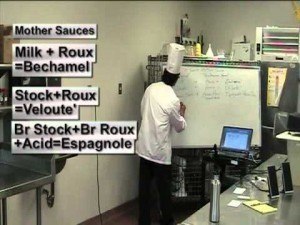The concept of having Mother Sauces from which to create most other sauces is a relatively new concept. Sauces have been used in cooking just about as long as fire has. Sauces in French cuisine date back to the middle ages. In those days, sauces were used to hide the bad texture and flavor of spoiling meats or preserving other foods by blocking out air.
In the early 1800’s the Father of Classical Cuisine, Antonin Careme devised an extensive list of sauces, estimated in the hundreds, that could never be duplicated because most were his one-time creations. My students in culinary school won’t be excited about memorizing hundreds of sauces, so they’re thankful for Auguste Escoffier.
Escoffier was “the chef to kings and the king of chefs” who simplified most of Careme’s lavish and lengthy efforts to create a list of only five that we call mother sauces today.
All sauces are categorized by two elements, their liquid and their thickening agent. The most often used thickener is Roux, which we reviewed in “How To Make Homemade Sauces Like The Pros”. However, the combination of fat and starch isn’t the only way to thicken a sauce so it will stick to food, that’s what can make these five sauces so tricky.
- Milk + Roux = Bechamel
The most often used of Escoffier’s list is Bechamel. This is made when milk is thickened with roux to create a basic white sauce. Bechamel is the start to all cheese sauces, Alfredo, mushroom, and the new sauce that you’ll create from the first of the mother sauces.
- Stock + Roux = Veloute’
A chicken stock or fish stock can be thickened with roux also to create a sauce that has the specific flavor of fish or chicken, but also the body and texture to compliment food. Veloute is most often used with the item that gave the flavor profile. A Fish Veloute would be excellent with roasted or sautéed fish. Chicken Veloute is perfect to add moisture to grilled chicken breasts with minimum effort.
- Brown Stock + Brown Roux + Tomato Paste = Espagnole
The two previous mother sauces are white or ivory colored because they’re made with milk or stock and a white or beige roux. None of these elements will add color to the sauce. But, a brown roux and brown stock with tomato paste will definitely add a distinctive brick red color to create Espagnole.
When you continue to cook your roux until it turns a nutty brown, then add a cold beef stock that was made from caramelized bones and vegetables, you’ll get a brown sauce with a lot of color and texture. Don’t forget that “Stock vs Broth Makes All the Difference” when creating these sauces, because the most flavorful ingredients yield the best tasting sauces.
- Tomato + Tomato Paste = Tomato Sauce
Tomato Sauce is one of the Mother Sauces but nobody seems to realize this. That’s because it seems everyone has made a tomato sauce, but you never hear someone bragging of their Grandma’s Veloute or Bechamel sauce!
Tomato sauce is perhaps the most simple of the top five sauces to make, but also takes the greatest patience. Peeled and Seeded Tomatoes are called “Concasse” (con-ka-say), and they serve as the liquid element. Tomato Paste and the process of evaporation and reduction by simmering the sauce serves as the thickener.
- Butter + Egg Yolk = Hollandaise
The fifth and most delicate to make of the mother sauces is Hollandaise. If you love a Sunday Brunch that includes Eggs Benedict, you’ve had this sauce before. It’s buttery, creamy with a hint of tartness and the texture of velvet when made correctly.
Clarified butter is whisked into egg yolks over a double boiler to create an emulsification, mixing the two unmixable items and keeping them in suspension to make perhaps the grandest of Escoffier’s creations. We covered the concept of emulsification in “Make Mayonnaise Yourself By Mixing Two Unmixable Items”.
These mother sauces don’t taste like much on their own, actually they’re quite bland. They’re meant to be a blank canvas upon which the chef adds flavors and textures to create a “small” sauce from one of its mothers.
Bechamel needs cheese, Tomato needs oregano and basil, Hollandaise needs a few drops of lemon and a pinch of cayenne pepper. They all need a bit of help and creative effort before being ladled over the perfectly cooked piece of meat you’ve created. Whatever inspiration you take from the five originals, make sure they remember and have respect for their Mother!
Discover the difference between how professionals and home cooks are taught in my next
FREE Webinar Workshop
Claim your FREE Spot for the next webinar session by CLICKING HERE



why do we season this mother sauce?
Hi Aura!
I don’t understand your question.